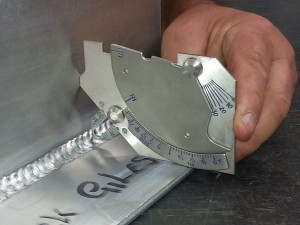Top Tips for Effective Welding Inspection in Gilbert Arizona: A Comprehensive Guide
Wiki Article
Discovering the Relevance of Welding Examination in Industrial Applications: Guarding Versus Failings and Enhancing Long Life
Welding assessment functions as a critical line of defense in industrial applications, guaranteeing the structural integrity and reliability of bonded parts. By methodically identifying defects such as porosity and incomplete combination, examinations not just avoid failings yet also expand the lifespan of essential assets. Following market criteria enhances both safety and operational performance; however, the implications of disregarding these practices can be extreme. As we take a look at the multifaceted benefits of routine examinations, it becomes apparent that comprehending these characteristics is not just an issue of conformity but a calculated important for longevity and threat reduction (Welding Inspection Gilbert Arizona).
Function of Welding Evaluation
Welding evaluation acts as a vital guard in industrial applications, making sure that welded structures meet specified requirements of high quality and safety and security. This process involves a systematic assessment of welds to validate their honesty, stamina, and conformity with well established codes and specs. The function of welding inspection is complex, including both visual evaluations and non-destructive testing techniques, which might consist of ultrasonic, radiographic, or magnetic fragment testing.
Additionally, welding evaluation plays a vital duty in regulative conformity. Eventually, the role of welding assessment is crucial in advertising safety, improving performance, and securing financial investments in commercial facilities.
Usual Welding Issues

One of the most widespread flaws is porosity, characterized by tiny gas pockets caught within the weld metal. This happens because of contaminants or incorrect shielding gas, endangering the weld's stamina. Another substantial defect is incomplete blend, where the weld steel fails to bond appropriately with the base product, possibly leading to architectural weak points.
Cracks can additionally create throughout or after the welding process, commonly credited to thermal stress and anxieties or improper cooling rates. Additionally, undercutting, where the base steel is deteriorated along the weld bead, can deteriorate the joint and is commonly brought on by extreme warmth input or incorrect technique.
Moreover, lack of infiltration happens when the weld metal does not reach the origin of the joint, resulting in inadequate stamina. Comprehending these usual defects is vital for assessors and welders alike to make sure that bonded frameworks fulfill safety and performance standards, ultimately preventing prospective failings in industrial applications.
Benefits of Routine Evaluations
Normal evaluations act as an essential guard in ensuring the dependability and longevity of bonded frameworks. These evaluations determine prospective defects and weaknesses that may endanger the stability of welds, enabling timely remediation before concerns intensify. By carrying out a structured inspection routine, companies can considerably reduce the danger of catastrophic failures that might bring about expensive downtime, equipment replacement, and even accidents.Additionally, regular assessments add to enhanced high quality control throughout the welding procedure. By adhering to a regular evaluation schedule, business can make certain that their welding techniques meet well established quality benchmarks and ideal methods. This not just fosters a society of liability however likewise motivates continual improvement among welding workers.
On top of that, regular evaluations help with better maintenance preparation. By recognizing wear and tear early, companies can purposefully set up repair services and replacements, reducing disturbance to operations. This proactive technique inevitably results in extensive property lifespan and boosted total efficiency.
Finally, a commitment to regular evaluations can enhance a business's reputation in the sector. Stakeholders and clients progressively value organizations that focus on safety and high quality, therefore boosting trust and potentially bring about enhanced organization opportunities.
Sector Requirements and Laws
Sticking to sector criteria and guidelines is a basic element of welding evaluation that enhances the benefits of routine examinations. These criteria, established by organizations such as the American Welding Society (AWS) and the American Society of Mechanical Engineers (ASME), offer a structure for best practices in welding procedures, materials, and inspection techniques. Conformity with these laws ensures that welds meet the required quality and safety criteria, dramatically reducing the danger of architectural failings.Regulatory bodies like the Occupational Security and Health Administration (OSHA) even more enforce standards that protect workers and the setting throughout welding operations. By adhering to these established standards, industries can boost the reliability of their parts and structures, ensuring they carry out as planned under different operational conditions.
Furthermore, adherence to market criteria promotes consistency in quality assurance, helping with smoother interaction amongst stakeholders and governing companies. This alignment not only reduces responsibility risks but likewise enhances the credibility of organizations in open markets. Inevitably, conformity click for more with welding criteria and policies is not simply a legal obligation; it is an essential financial investment in safety and security, performance, and long-term operational success.
Future Trends in Welding Inspection
As markets proceed to evolve, the future of welding examination is poised to integrate advanced modern technologies that boost precision and effectiveness. One of the most significant fads is the fostering of automation and robotics in inspection look at this website processes. Automated systems can perform assessments quickly, lowering human error and increasing throughput in making settings.Furthermore, the assimilation of expert system (AI) and artificial intelligence algorithms will enable predictive analytics, enabling real-time assessments and aggressive upkeep (Welding Inspection Gilbert Arizona). By examining data from previous examinations, these modern technologies can identify patterns that might show possible failures, therefore expanding the life-span of welded elements

In addition, the trend towards digitalization will result in improved information management systems that promote much better tracking, reporting, and conformity with market criteria. In summary, the future of welding evaluation is identified by technological advancements that guarantee to dramatically enhance dependability, safety and security, and operational effectiveness in various industrial applications.
Verdict
Finally, welding evaluation offers a crucial feature in making certain the stability and longevity of bonded frameworks across various commercial applications. By recognizing flaws such as porosity and incomplete combination, regular examinations play a considerable duty in danger reduction and top quality guarantee. Adherence to sector standards and laws additionally boosts operational safety and security and reliability. As improvements in technology continue to evolve, the future of welding evaluation promises enhanced accuracy and efficiency, ultimately adding to the durability of important frameworks.Welding evaluation offers as an important line of defense in industrial applications, making sure more information the structural honesty and integrity of bonded components.Welding assessment offers as a crucial guard in commercial applications, ensuring that bonded structures satisfy defined requirements of high quality and security - Welding Inspection Gilbert Arizona. Ultimately, the role of welding examination is essential in advertising safety and security, enhancing efficiency, and securing investments in commercial infrastructure
These criteria, developed by companies such as the American Welding Culture (AWS) and the American Culture of Mechanical Designers (ASME), offer a framework for finest techniques in welding processes, materials, and inspection techniques.In conclusion, welding assessment serves an important function in ensuring the stability and durability of bonded frameworks throughout numerous commercial applications.
Report this wiki page